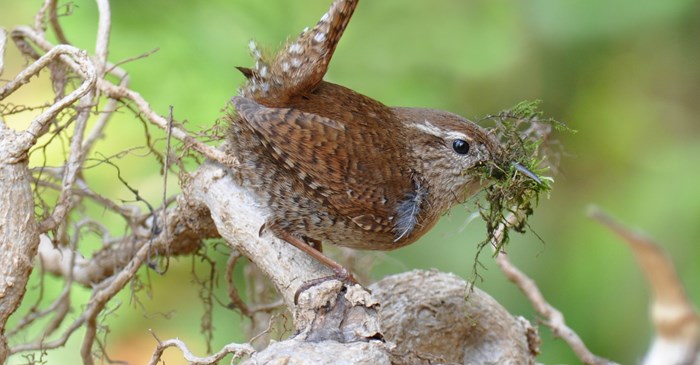Creating a natural habitat that is, from a bird’s eye view, the most desirable real estate on your block is both a scientific and creative process. Understanding the species of birds that nest in your part of the country is a first step. By learning about the nesting habits of these birds, you can build or buy nesting houses, bird feeders, bird baths and moving water features, all with the goal of attracting generations of bird tenants. But there is one task that’s very difficult for these amazing creatures with extraordinary skills—the task of building a nest. We as their human helpers can make it much easier for them. And everything they need is available right in your backyard or lying around the house.
The labor involved in nesting is significant. Birds seek out a nesting site and may try several before narrowing down the choices to one. Once they’ve chosen the site, they must then locate nesting materials and carry them to the nest site. This takes many repeat trips from source to nest and the birds may have to forage around, flying from yard to yard, before they have gathered the type and quantity of the material they need to build a proper comfy nest. Here’s where you come in. To help make the job easier, you can gather nesting material for them from the various locations throughout your yard and place them near the nesting houses to make it even more convenient for them.
Providing attractive and secure nest sites plus all the nest-building material they need, will further increase your chances of attracting the birds you want to visit.
Natural materials you may find in your backyard like straw, small sticks, and twigs can be supplemented by human-made items such as yarn, string, dog, cat or horse hair, feathers from old down pillows, and thin strips of cloth, as long as these materials are natural colored and un-dyed.
Other natural backyard sources of nesting material include:
- Dried grasses
- Long wilted leaves from daffodils, tulips or iris
- Spanish or regular moss
- Pine needles
- Milkweed silk, which is sought after by the American Goldfinch and Orioles
Please don’t use plastic bags, dryer sheets or dryer lint. When wet or dried, these can be toxic at worst and turn to a hardened mess at best.
Just before the nesting season in your area of the country, try using suet cages or small mesh feeders to distribute the nesting materials throughout the yard, near nesting boxes and natural nesting sites. Some birds, like Robins, use mud and grass to construct their nests, so you might consider creating a muddy puddle in your yard for them. Butterflies love mud too!
While taking walks around your neighborhood or property, look for the various types of nests preferred by local birds like cavities in trees or wood, cups, baskets, mud tubes, platforms and some simply build their nests on the ground.
- In cavities: Woodpeckers often create these in trees. Cavities make homes for many species, including tree swallows, woodpeckers, nuthatches, chickadees, house wrens, bluebirds, and more. Some birds may even build a nest in human-made structures, like stove vents, dryer vents, chimneys, and under shingles. Thoughtful birders offer human-made birdhouses like the Lyric Custom Nesting Box.
- In cups: Birds build nest “cups” on ledges or on a branch. These cups are woven bowl-shaped nests made from grass, leaves, string, hair, and mud or saliva that acts as an adhesive. Preferred by blackbirds, goldfinches, robins and barn swallows, birds also build them on artificial nest platforms secured to the side of your house or garage.
- In woven baskets: The Baltimore oriole is a basket weaver! Along with the bushtit and other species of birds, they make intricate grass baskets that hang from a branch. And although these structures may appear delicate and fragile, they are made of tough moss, hair, and plant fibers that keep them together even on the windiest days.
- In mud tubes: Birds like Cliff Swallows travel far and wide to a mud source and back to a bridge, building, or cliff wall to build their tubular nest. They mix mud with saliva to hold it all together.
- On ledges or platform: Other birds like raptors, gather branches, twigs, grass, and herbs into a mass to build their nests on top of a platform. Hawks build these in protective areas, away from predators. Larger platforms are built by osprey and eagles.
- In tunnels: Fish-eaters like Kingfishers and Puffins dig tunnels in dirt banks or on cliff edges where they can have better hunt prey. Some owls use the tunnels created by ground squirrels.
- On the ground: Shorebirds, ducks and some song birds and owls simply build their nests on the ground, protected by merely a bush or some form of vegetation.
With saliva or mud as the glue that binds the nesting materials together, birds will use an incredibly inventive array of materials, both natural and human-made, to line their nests. From grass, mud, feathers, and twigs, to spider webs, snake skin, shells, fur, string, plastic, buttons and shoelaces, there is an abundance that can be made available in each and every yard and home. Birds also use many materials as a security measure to ward off predators: they use manure to disguise the scent of their brood, smear pitch around the entry hole with inserted ants, and some build a nest near bees and wasps to keep parasites away. And they are also smart enough to use materials like spider and insect silk that repel moisture and shelter them from the rain.
So just remember that you can help make your yard a better place for birds. Building a nest—it’s a big job for birds, and by making available a wide range of natural and human-made materials in convenient locations, you’ll lighten their burden and encourage more nesting in your backyard!
